Other uses
- Hampton Court (TV series), Australian television series
- HMS Hampton Court (1678), a ship
- HMS Hampton Court (1709), a ship
Hampton Court usually refers to Hampton Court Palace, a palace and former royal residence in south west London, England.
Hampton Court may also refer to:

1604 (MDCIV) was a leap year starting on Thursday of the Gregorian calendar and a leap year starting on Sunday of the Julian calendar, the 1604th year of the Common Era (CE) and Anno Domini (AD) designations, the 604th year of the 2nd millennium, the 4th year of the 17th century, and the 5th year of the 1600s decade. As of the start of 1604, the Gregorian calendar was 10 days ahead of the Julian calendar, which remained in localized use until 1923.
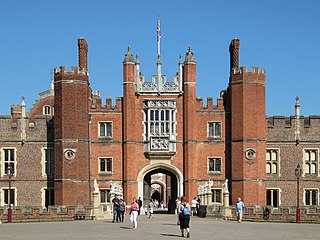
Hampton Court Palace is a Grade I listed royal palace in the London Borough of Richmond upon Thames, 12 miles southwest and upstream of central London on the River Thames.

Hampton is a suburban area on the north bank of the River Thames, in the London Borough of Richmond upon Thames, England, in the historic county of Middlesex. Hampton is bounded by Bushy Park to the east, the suburbs of Hampton Hill and Fulwell to the north, green belt to the west, and the Thames to the south. Historically, the area known as Hampton included Hampton Court Palace, Hampton Hill, and Hampton Wick.

James VI and I was King of Scotland as James VI from 24 July 1567 and King of England and Ireland as James I from the union of the Scottish and English crowns on 24 March 1603 until his death in 1625. Although he long tried to get both countries to adopt a closer political union, the kingdoms of Scotland and England remained individual sovereign states, with their own parliaments, judiciaries, and laws, both ruled by James in personal union.

St James's Palace is the most senior royal palace in London, the capital of the United Kingdom. The palace gives its name to the Court of St James's, which is the monarch's royal court, and is located in the City of Westminster in London. Although no longer the principal residence of the monarch, it is the ceremonial meeting place of the Accession Council, the office of the Marshal of the Diplomatic Corps, and the London residence of several members of the royal family.

The Treaty of London, signed on 18 August O.S. 1604, concluded the nineteen-year Anglo-Spanish War. The treaty restored the status quo between the two nations. The negotiations probably took place at Somerset House in Westminster and are sometimes known as the Somerset House Conference.
Nonsuch may refer to:

The Hampton Court Conference was a meeting in January 1604, convened at Hampton Court Palace, for discussion between King James I of England and representatives of the Church of England, including leading English Puritans. The conference resulted in the 1604 Book of Common Prayer and, in 1611, the King James Version of the Bible.
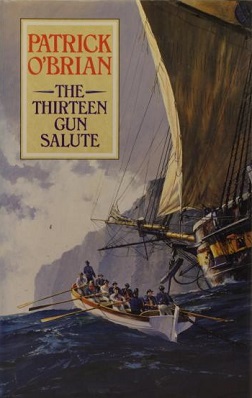
The Thirteen-Gun Salute is the thirteenth historical novel in the Aubrey–Maturin series by Patrick O'Brian, first published in 1989. The story is set during the Napoleonic Wars and the War of 1812.
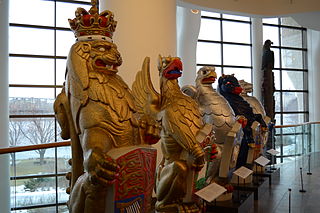
The Queen's Beasts are ten heraldic statues representing the genealogy of Queen Elizabeth II, depicted as the Royal supporters of England. They stood in front of the temporary western annexe to Westminster Abbey for the Queen's coronation in 1953. Each of the Queen's Beasts consists of a heraldic beast supporting a shield bearing a badge or arms of a family associated with the ancestry of Queen Elizabeth II. They were commissioned by the British Ministry of Works from the sculptor James Woodford, who was paid the sum of £2,750 for the work. They were uncoloured except for their shields at the coronation. They are now on display in the Canadian Museum of History in Gatineau, Quebec.

John Overall (1559–1619) was the 38th bishop of the see of Norwich from 1618 until his death one year later. He had previously served as Bishop of Coventry and Lichfield, as Dean of St Paul's Cathedral from 1601, as Master of Catharine Hall from 1598, and as Regius Professor of Divinity at Cambridge University from 1596. He also served on the Court of High Commission and as a Translator of the King James Version of the Bible.

Princess Frederica of Hanover was a member of the House of Hanover. After her marriage, she lived mostly in England, where she was a prominent member of society.
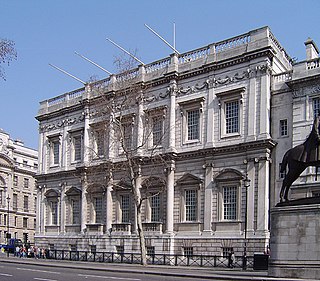
The Banqueting House, on Whitehall in the City of Westminster, central London, is the grandest and best-known survivor of the architectural genre of banqueting houses, constructed for elaborate entertaining. It is the only large surviving component of the Palace of Whitehall, the residence of English monarchs from 1530 to 1698. The building is important in the history of English architecture as the first structure to be completed in the classical style of Palladian architecture which was to transform English architecture.
President most commonly refers to:

Thomas Ravis was a Church of England bishop and academic. He was among those engaged in translating the King James Bible.

The Diamond Jubilee State Coach is an enclosed, six-horse-drawn carriage that was made to commemorate Queen Elizabeth II's 80th birthday, but completion was delayed for nearly eight years. Eventually, it became a commemoration for the Queen's Diamond Jubilee.

Thomas Dunckerley was a prominent freemason, being appointed Provincial Grand Master of several provinces, promoting Royal Arch masonry, introducing Mark Masonry to England, and instituting a national body for Templar masonry. This was made possible by an annuity of £100, rising to £800, which he obtained from King George III by claiming to be his father's illegitimate half brother.
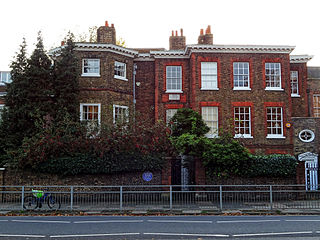
The Old Court House is a Grade II* listed house located off Hampton Court Green in the London Borough of Richmond upon Thames; its origins date back to 1536. The architect Sir Christopher Wren, who lived there from 1708 to 1723, was given a 50-year lease on the property by Queen Anne in lieu of overdue payments for his work on St Paul's Cathedral. The lease passed from Wren's son to his grandson. It was purchased from the Crown Estate in 1984.
Two ships of the Royal Navy have borne the name HMS Hampton Court:

The 1604 Book of Common Prayer, often called the Jacobean prayer book or the Hampton Court Book, is the fourth version of the Book of Common Prayer as used by the Church of England. It was introduced during the early English reign of James I as a product of the Hampton Court Conference, a summit between episcopalian, Puritan, and Presbyterian factions. A modest revision of the 1559 prayer book, the Jacobean prayer book became the basis of the 1662 Book of Common Prayer, a still-authorized liturgical book within the Church of England and global Anglicanism.